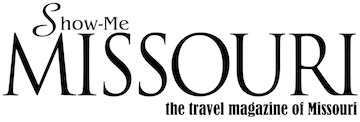The Story of Being Human
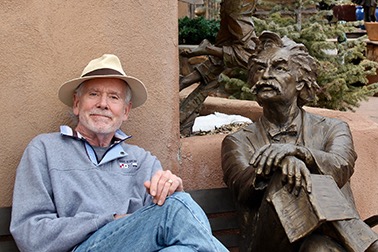
These are just a few of the dozens of presentations ready and willing to visit your town, your group, organization or local library. In fact, the Missouri Humanities Council may already have an event scheduled near you.
The council provides a list of 52 topics available through the Missouri Speakers Bureau. The bureau offers a list of highly qualified public speakers on a wide variety of topics about Missouri people, culture, history and geography. If you have ever been responsible for scheduling a speaker to spice up your upcoming meeting, you know the difficulty of coming up with unique presentations. As you search for that perfect presentation, check out the lineup from the Missouri Speakers Bureau.
With a tip of the cowboy hat to the real Rawhide, saddle up vicariously with the vaqueros, the first Hispanic cowboys who made the cattle drives to Sedalia and Kansas City successful.
Hear the dramatic story about the largest drainage project in the world. Within two decades, Bootheel swampland was converted into one of the richest agricultural regions in the nation.
Learn the stories of great African American women in Missouri, like Annie Malone and Harriet Scott.
Topics are as varied as Missouri’s vast and diverse history and culture, from the founding of Lincoln University, to a different perspective on the tragic Trail of Tears or the establishment of Missouri’s 19th-century utopian communities.
Listen to an oral historian recount stories from the Ozarks. Or find out why prairies matter, and learn the benefits of native plants, including pollinator habitats. Get insights to the Civil War through glimpses of 400 letters written between a husband and wife during the conflict, or follow the exploits of William Quantrill, “father of post-Civil War Missouri banditry.”
You can see a roster of the available presenters and presentations at MoHumanities.org/schedule-a-speaker/. The website offers details about how to contact and arrange speaker presentations.
I have been on both sides of the situation: looking for just the right speaker for a group, and now, as a member of the Speakers Bureau. My subject is titled “A Road Trip into America’s Hidden Heart.” I tailor my presentation to the location and the group. On March 23, I’ll join the Ozark Natural & Cultural Resource Center in Salem for the opening of a Smithsonian traveling exhibit named “Crossroads: Change in Rural America.” And on May 14, I’ll speak at the History on Elm lecture series at the State Historical Society of Missouri in Columbia.
Remember what Harry Truman said: “The only thing new in the world is the history you don’t know.”
If you have a Missouri story to tell, contact the Missouri Speakers Bureau. Presenters are selected through an application process.
Rediscovering Missouri
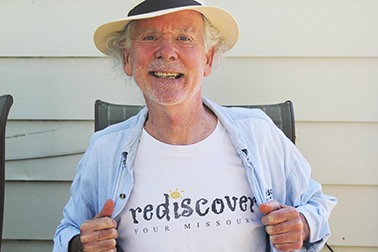
That white-knuckle flight marked a sea change in promoting Missouri: we launched a campaign to encourage Missourians to vacation in Missouri.
Before 2001, Missouri’s state tourism division advertised predominantly in markets outside the Show-Me State. But the terrorist attack on the World Trade Center changed the world forever. It was a gut punch every American took personally. The staggering loss of life. The feeling that our open society—our ability to move freely—had been deeply wounded. In the immediate aftermath of 9/11, Americans changed basic habits. We stayed closer to home, closer to family.
The day after the attack, Lt. Governor Joe Maxwell and I (his chief of staff) huddled with state tourism officials, including Interim Director Bob Smith who had stepped up to fill the shoes of Chris Jennings who had guided the state into the modern marketing era. We all recognized the problem: It was taboo in the Missouri tourism industry for the state to advertise to Missourians. Let the local attractions take care of that. But in this new environment of fear, people were staying very close to home.
I suggested the obvious: Missouri dollars spend as well in Marceline as in Orlando or Anaheim. Use the state’s significant marketing power to promote Missouri to Missourians.
The result? From the ashes of tragedy, Rediscover Your Missouri was born, urging Missourians to “check out your own back yard.” The state would use significant resources to promote attractions big and small to our own residents. We would even promote Missouri State Parks and conservation areas, which for some inane reasoning, were prohibited from advertising their own sites.
We planned a detailed rollout that took us to 11 airports in 11 strategic markets.
We took off from Jefferson City in morning darkness, landing at a Bootheel airstrip where the wind threatened to blow out the sun as it peeked above the horizon. Greeting us in the dawn’s early light was the publisher of a travel magazine that was still in its infancy.
With time and distance from 9/11, people began traveling more and farther. But Missouri’s tourism marketing strategy had changed forever to include an in-state audience and to finally promote the Show-Me state via home-grown media like Show-Me Missouri magazine.
Congratulations, Gary Figgins, on 25 great years. In my five decades of working closely with those unique Missouri Press Association members who wear many hats as writer, editor, publisher, columnist, photographer, layout artist, ad manager, circulation manager and chief cook and bottle washer, I can say that nobody does it better than you.
John’s new book, “Souls Along The Road,” caroms through Missouri destinations, forgotten history, remarkable people and memorable food.
EXERCISE TIGER
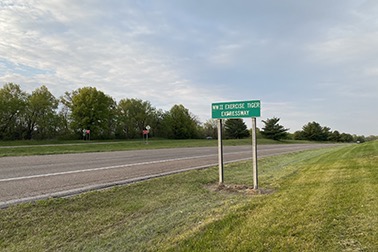
On the road between Kingdom City and Auxvasse thousands of travelers pass a sign designating a stretch of Highway 54 as WWII Exercise Tiger Expressway. Most of them don’t know what Exercise Tiger means.
It’s the story about the ambush that left the fate of hundreds of local soldiers and sailors shrouded in mystery for a half century.
Decades passed before Leonard Bruns learned what really happened. He remembers that cold April night in 1944, when he was a 19-year-old Army corporal, just one soul doing his part to prepare the world for peace. Under cover of darkness, his squad stormed a beach with advance troops and engineers. The beach was Slapton Sands, on English soil.
At the time, he wasn’t aware of the scope of the mission. This event was a rehearsal for D-Day, the pivotal invasion that would turn the tide of war in the Allies’ favor.
“I was in the signal corps,” Leonard recalls, “attached to the engineers. My job was communications, setting up phone lines on the battlefield and signals from ship to shore. When this thing occurred, we were already on the beach.”
“This thing” turned into a bloody German assault. Allied commanders picked Slapton Sands as a practice area because it resembled the D-Day target at Utah Beach. Just off that English coast, in the darkness, a random patrol of nine German naval torpedo boats discovered eight U.S. LSTs (landing ship tanks) carrying soldiers to the landing area. The hour-long attack left 749 Allied troops dead, including soldiers and sailors from Missouri, especially Boone, Callaway and Audrain Counties.
In his book, “The Forgotten Dead”, Ken Small suggests that Exercise Tiger “was never covered up; it was ‘conveniently forgotten.’”
David Troyer knew about it. He was an Army private first class among “the first army units to take amphibious training. In Southampton, we boarded ship and headed for Slapton Sands, but we didn’t know why at the time. We were onboard a landing craft away from the LSTs that were attacked.”
Troyer has spent much of his life piecing together the details of that night. “Everything went wrong that could possibly go wrong,” he says. There was only one gunboat escort as one other escort had collided with another ship and had left for repairs. LST531 was hit by two torpedoes, sank in six minutes. The British and American navies were on two different radio frequencies, so when the LSTs called for help, nobody came. LST515 went back to pick up survivors, against orders. The captain was court martialed and demoted.”
In the confusion, soldiers were taken out by friendly fire during the live fire exercise.
“Next morning, they moved us off the beach right quick. We were sworn to secrecy,” he says. “We bivouacked five weeks in an isolated area. The night before D-Day they served us steak with cherry pie and ice cream at midnight. Then, because of weather, the landing was postponed for 24 hours. So our ‘last meal’ ended up being K-rations.”
Now when you pass that Exercise Tiger Memorial Highway sign, you’ll know the whole story.
Don't Go In There
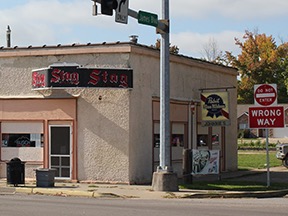
“Don’t worry, Mom, I’ll never go in there.”
But in life, a young boy’s perspective evolves. Moms just don’t understand that places like Johnnie’s have the elixir that can subdue frightful images of devils and demons, dioxin and death.
Or bring them out.
Soon I was immersed in the culture of the locals in the low light of this tavern, a delightful throwback to the days when the barroom was filled with rail passengers and conductors and brakemen and engineers laying over.
Hours later, having dipped liberally into John Barleycorn’s reserves, I paid my bill and threw down a liberal tip and walked out the door.
I was walking to the edge of town, preparing to hitchhike home, when I saw a single car, a sleek silver hearse approaching. It was going my way, but in reverence to its passenger, I showed no thumb, instead placing my hand over my heart and bowing my head. As the hearse passed, it slowed to a stop. Its backup lights told me that the hearse was coming back for me. Even significant whiskey impairment couldn’t dull my panic. As the hearse drew nigh to my startled face, the passenger window rolled down and the voice from the driver’s seat called out.
“John Robinson!”
I swallowed hard and leaned into the hearse’s open window, expecting to meet the Grim Reaper. Instead, I saw the familiar face of an old friend from high school.
“What are you doing way down here?” he asked.
“Son of a bitch!” I think I shouted, as a feeling of relief washed through my veins.
For reasons of good taste and legal advice, I’ll protect the anonymity of the driver and his pallid passenger. I have no idea who his passenger was, since the casket was closed. Suffice it to say the three of us had a pleasant ride to my destination, and two of us had a great conversation.
“So long, buddy, and thanks for the ride.” I hopped out and he drove away in the general direction of his passenger’s final stop.
This and other stories are part of John’s third book, “Coastal Missouri: Driving the Edge of the Wild.” You can read more of John’s travels at JohnDrakeRobinson.com.
The Missouri Waltz

The Mizzou band begins the familiar strains of the Missouri Waltz. Then the song morphs into a march that brings the crowd to its feet, inspired, hands clapping.
The waltz turns into a march because, well, have you ever tried to march to a waltz?
That’s not the first time the song has been altered. Early in its life, the melody that became the Missouri Waltz apparently got hijacked from its creator.
Supporters of “Jelly” Settle, a composer from New Franklin, Missouri, claim he wrote the tune that became famous when President Harry Truman played it, and eventually became the state song. Jelly’s not talking. He was born in New Franklin, died in New Franklin, and somewhere in between, he wrote a tune called Graveyard Waltz. His friends say other musicians showed interest in the tune and matched the melody to words that eventually became the state song, the one Harry Truman played.
But Settle didn’t get any credit until he was dead. Settle’s supporters claim somebody stole the melody from this poor guy, published it, made it famous, and took the credit.
Even folks around Jelly’s hometown don’t know about him. I stopped at the New Franklin School to find his whereabouts.
“You know the cemetery where the guy who wrote the Missouri Waltz is buried?” I asked the lady who greeted me in the school office.
“Not familiar with that,” she said, “but there’s a cemetery about two miles up Highway 5 toward Boonsboro. Mount Pleasant.”
Sure enough, Highway 5 led me to a sign that read:
Mount Pleasant Cemetery
Burial site of
J. Edgar “Jelly” Settle
Composer of the Missouri Waltz
A short drive down a gravel road leads to the cemetery, a beautiful spot on a sloping hilltop framed by forest land, overlooking undulating hills packed with mature cornstalks, holding their ears like pistols, patiently awaiting the reaper. I parked and waded into the rows of tombstones, all shapes and sizes. My eye kept landing on the bigger monuments, expecting to see the name Settle. I finally stumbled onto a modest stone about collie-high, with a modest inscription.
The Missouri Waltz wasn’t his only song. Composer, pianist, painter and poet David Thomas Roberts calls Jelly Settle’s XL Rag a “gorgeous haystack-of-a-piece published in Sedalia... Let this suffice: it is the ultimate hymn of outstate Missouri.”
Sounds like XL Rag could have been the state song. Maybe somebody stole the wrong one.
Read more about “Jelly” Settle, as well as other notable Missourians, at JohnDrakeRobinson.com.
